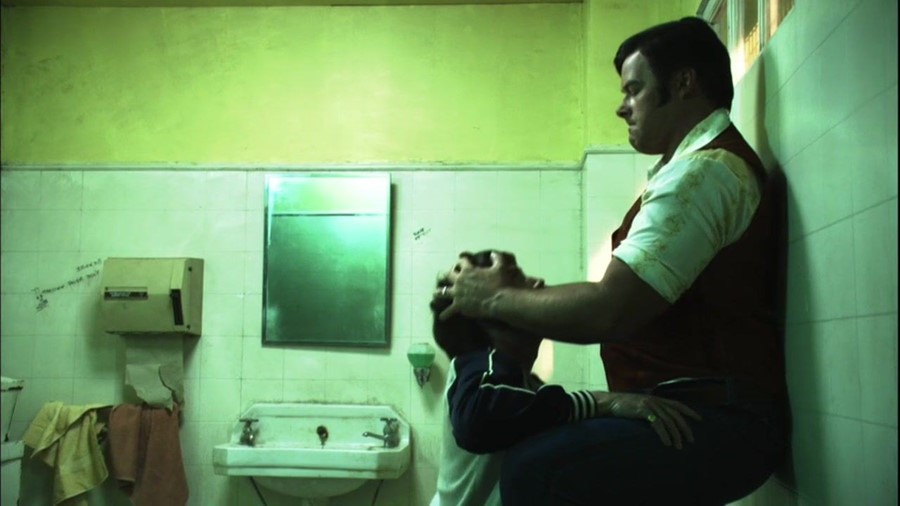No justice, no piss: public toilets have always been a site of moral panic, but what is really driving the government’s weird new obsession with them?
This week, the UK government announced that all new public buildings – such as offices, schools, hospitals and entertainment venues – must have separate, single-sex toilets, in a move designed to curb the sole use of gender-neutral facilities.
The plan is a blatant “anti-trans dog whistle” according to Cleo Madeleine, communications officer at trans NGO Gendered Intelligence. “There absolutely is a crisis in public toilet provision in England, but it has nothing to do with gendered spaces,” she tells Dazed. “We need more facilities for disabled people, more facilities for people with young children, and more facilities for unhoused people. Using transgender people as a political football only serves to distract from these real issues.”
While transphobia is the British media’s moral panic du jour, public bathrooms have always been an intensely politicised site. Not coincidentally, successive freak-outs about who has been using them and for what purpose has gone alongside their continuing disappearance. A 2016 BBC article found that at least 1,782 facilities had closed across the UK in the previous decade, while in London, it’s estimated that about half of public toilets have been closed. A result of over a decade of Tory austerity, this decline has had a disastrous effect on our health and wellbeing as a nation. A 2019 report by the Royal Society of Public Health found that two out of five people who have conditions that require frequent toilet use don’t leave the house as often as they like due to a lack of facilities. This becomes a way of enforcing social isolation on some of the most vulnerable in our society, including elderly and disabled people – many of whom are afraid to venture far from their own homes as a result. But it can make the experience of navigating the public sphere unpleasant for everyone: according to the report, over half of the public restricts fluid intake due to concern over the lack of toilet facilities – a strategy which can have serious health ramifications.
In place of public amenities, we have shifted towards a privatised approach, with shops, bars and restaurants expected to fill in the gaps. But using private facilities is often easier said than done: you usually have to be in the position to spend money (and even then, there’s nothing more annoying than having to waste three quid on a coffee just to be able to relieve your bladder), or at least look like the kind of person who might be able to spend money. “Providing bathrooms means welcoming the world and being okay with it,” writes Leslie Lowe in No Place to Go: How Public Toilets Fail Our Private Needs. “There’s an element of people – unhoused people, drug dealers or drug users, those cruising for sex or looking for a place to nap – that businesses usually want to keep out, and that goes even if those folks only want to come in to actually use the bathroom.”
It’s clear that the lack of public toilets is a problem. But in response, cash-strapped councils have invoked the spectre of various minority groups to justify their decision not to provide them. This is partly formed out of a sincere (if ugly) desire to police who is allowed in public spaces, and partly a convenient way of saving money in the face of budget cuts. While the current panic around public toilets is targeted at trans people, throughout recent history it has been gay men who have been demonised and eventually used as a pretext to close facilities. This is particularly related to anxieties around cottaging (the practice of gay men cruising public toilets for sex, but also sometimes friendship and community.) “Whilst cottaging was nothing new following the 1967 act, which made homosexuality legal in private, it was policed very differently thanks to the partial and limited decriminalisation,” explains Thomas Ward, a researcher in queer history at Queen’s University Belfast. “Prosecutions for cottaging, such as gross indecency and lewd behaviour, rose substantially following the 1967 Act. The police became better at entrapment, leading to the ‘pretty policeman’ phenomenon whereby the police would attempt to solicit men they believed to be cottaging or anyone who presented outside masculine norms, and arrest them for gross indecency. This itself led to a number of moral panics around gay sex in public toilets throughout the 1970s, 1980s and 1990s.” These anxieties led to the closing down of public toilets and other council spaces, often in the face of public expenditure cuts.
“It’s about making the public sphere harder and harder for people to navigate. It’s about sending implicit messages that ‘we don't want you using public facilities because we do not think you are a legitimate part of public life’” – Jo-Anne Bichard
Just as gay men were the preferred folk devil in the 80s and 90s, today it is homeless people who are routinely used as an excuse to keep toilets facilities inaccessible: think of the automated toilets that close automatically after a certain time to prevent people from sleeping there, or the keycode systems in chain cafes which make it impossible to nip in from the street. The criminalisation of going to the toilet outdoors is a way of effectively making it illegal to be homeless. Recently, police in large US cities have swept homeless encampments and removed all of the portable toilets, depriving those living there of even this basic dignity. While the situation isn’t quite as severe in the UK yet, as Jessica Turtle, co-founder of archival and activist group Museum of Homelessness tells Dazed, we are moving towards more punitive enforcement.
“It’s about basic rights,” says Turtle. “For people in our community who experience street homelessness, being able to navigate and survive street life is often dependent on figuring out where toilets are accessible.” This all came to a head in the 2020 winter lockdown. Westminster council shut down all of its public toilets and all of the bars and cafes were closed: the Museum of Homelessness responded by handing out thousands of RADAR keys (a skeleton key that allows people to open thousands of disabled toilets across the UK). This was an effective piece of direct action, but the long-running problem of homeless people being excluded from basic amenities remains.
People who use drugs are another demographic who face hostile design practices – which almost always have adverse effects on other groups. “Prevention measures aimed at stopping drug use in toilets have had unintended consequences for disabled people,” explains Professor Jo-Anne Bichard, Professor of Accessible Design at the Royal College of Art. For instance, shelf spaces are necessary for people with colostomy bags, but they’re often removed to make it impossible to crush up drugs. The practice of installing UV lights so that people can’t find veins when injecting heroin has made accessing these spaces more difficult for elderly people; people with visual impairments, some autistic people and, obviously, anyone who needs to inject drugs for medical purposes– when you consider how common conditions like diabetes are, this is clearly exclusionary to a significant percentage of the population.
“Trans people have been using – and will continue to use – public toilets corresponding to their gender for as long as public toilets have been around. As we have seen in the US, the people who end up excluded by these kinds of policies are gender non-conforming cis women” – Cleo Madeleine
Efforts to make it safer for people to inject in public toilets – such as installing needle bins – have been met with resistance on the basis that they risk encouraging drug use, and are discouraged by official guidance for that very reason. But it would be wiser to plan around how people are actually using spaces, however unsavoury you think these behaviours are. And if we introduced safe, supervised drug consumption rooms (which have been successful in US cities like New York and Philadelphia) then people wouldn’t need to inject in public toilets in the first place. Instead, councils prefer to exploit people who use drugs as an excuse to shut down facilities for everyone, or at least make them significantly worse. “These design interventions always seem to focus on a minority, and then at the same time, exclude the majority,” says Professor Bichard.
It’s clear that public toilets have long acted as a flashpoint for moral panics, and that this is to the detriment of their continued existence. It would be reductive to claim that all of these phenomena are the same, but certain anxieties connect them. “While the situation with trans bathroom panics is not directly analogous to the gay sex cottaging panics of the 1990s, there are similarities,” says Ward. “I think they both represent attempts to control both public space and gendered presentation and conformity. It’s about making the public sphere harder and harder for people to navigate. It’s about sending implicit messages that ‘we don't want you using public facilities because we do not think you are a legitimate part of public life’. Trans people are being told that, more or less, today.”
The decline of public toilets has made life worse for just about everyone and continues to affect vulnerable groups – from homeless people to the elderly – the most. This is why the anti-trans toilet hysteria is so frustrating: it fails to get to the heart of the problem, it won’t make things better for anyone, and it does nothing to redress the genuine disparities which women face when it comes to provision. “This plan claims to protect women, but it will have the opposite effect,” Madeleine tells Dazed. “Trans people have been using – and will continue to use – public toilets corresponding to their gender for as long as public toilets have been around. As we have seen in the US, the people who end up excluded by these kinds of policies are gender non-conforming cis women.” In the face of Britain’s severe lack of basic amenities, to focus on which public toilets a small minority are allowed to use is, at absolute best, a trivial distraction. What public toilets?

